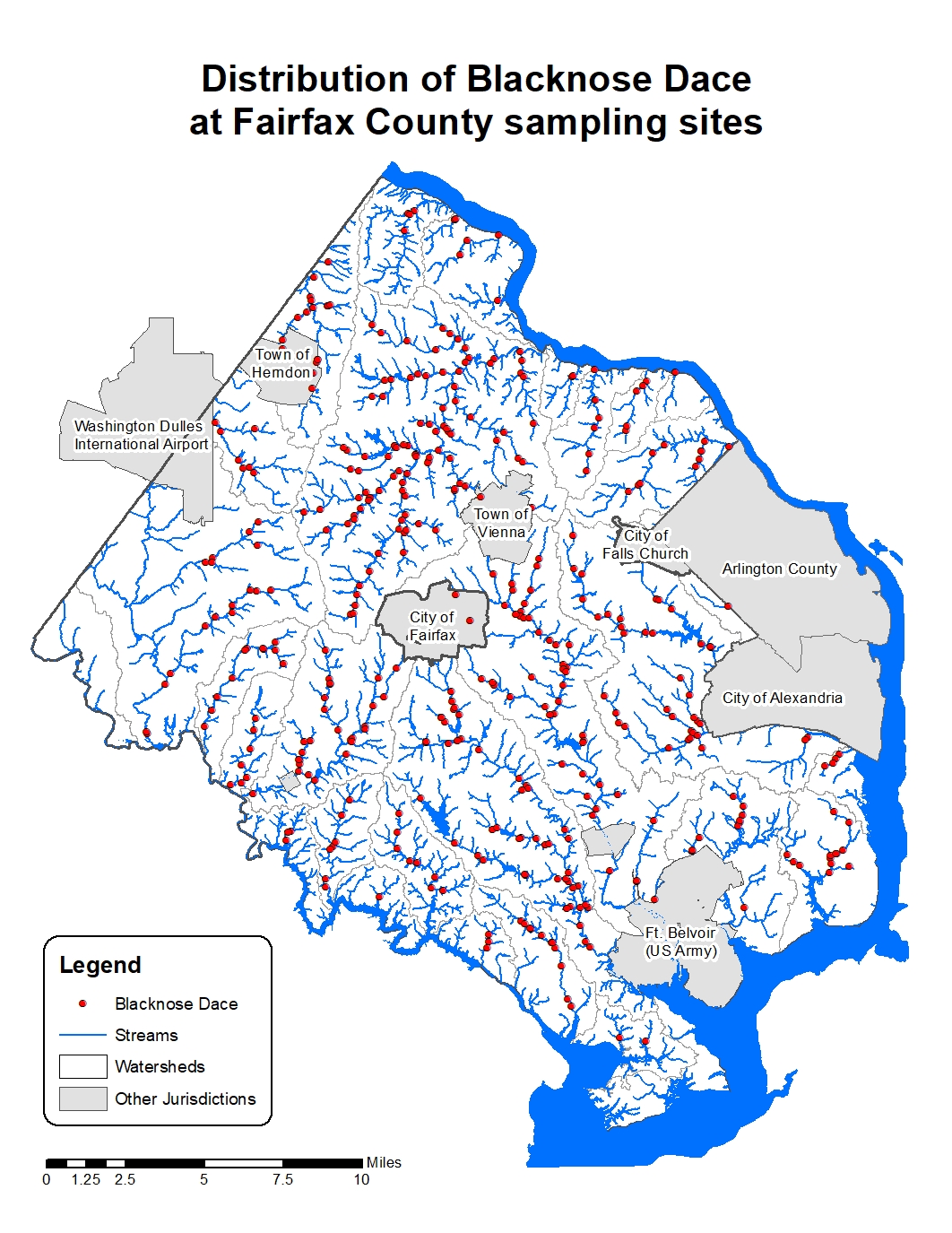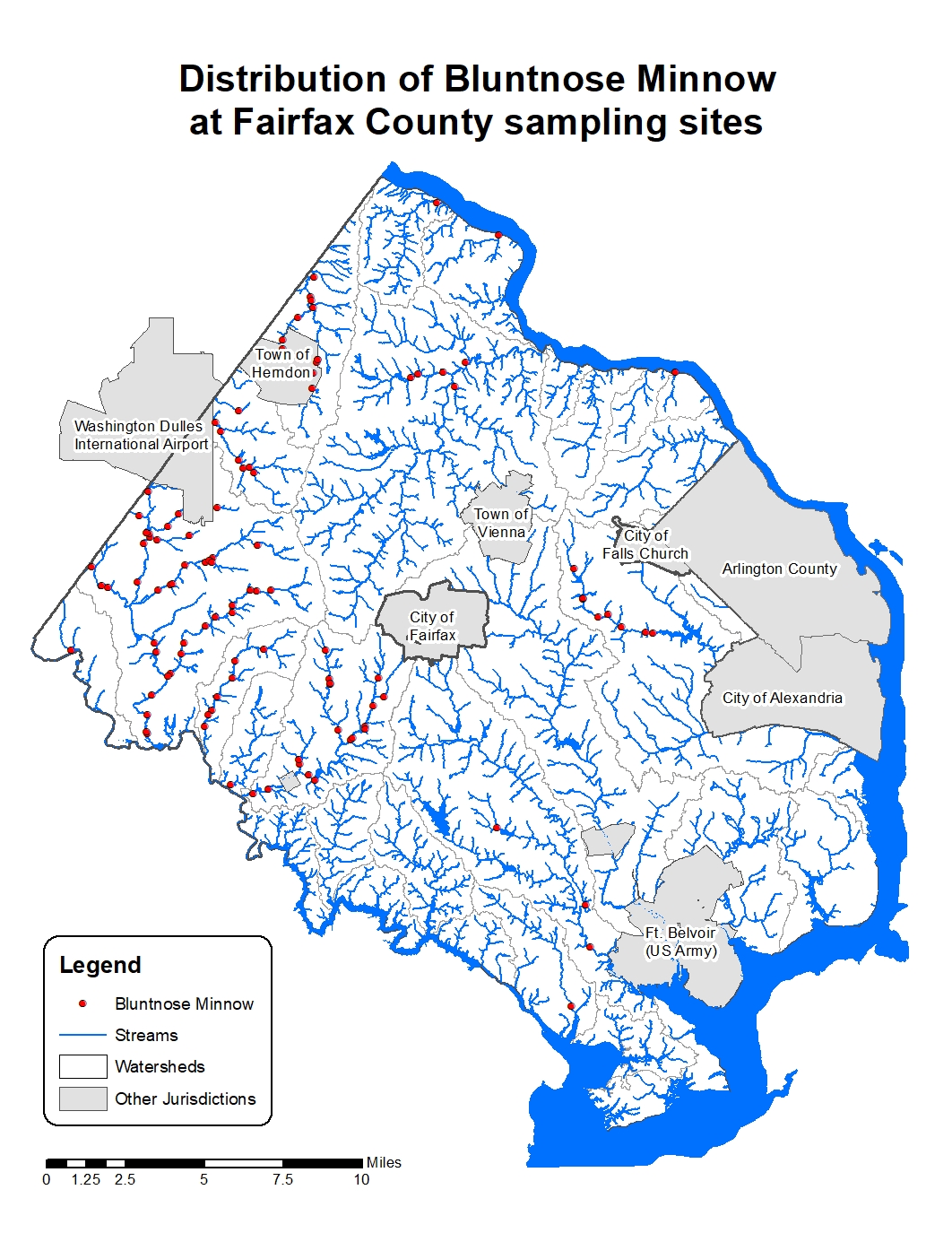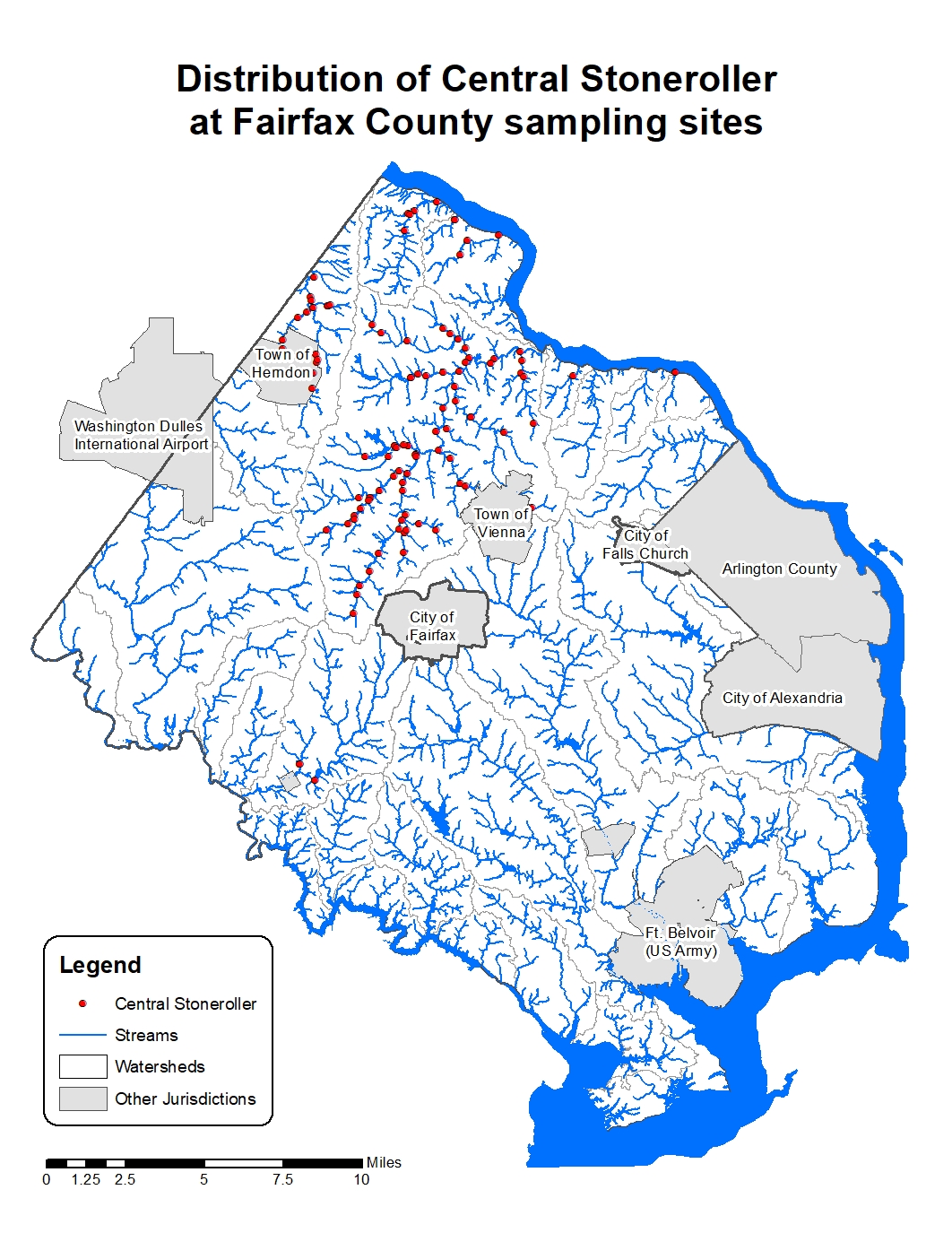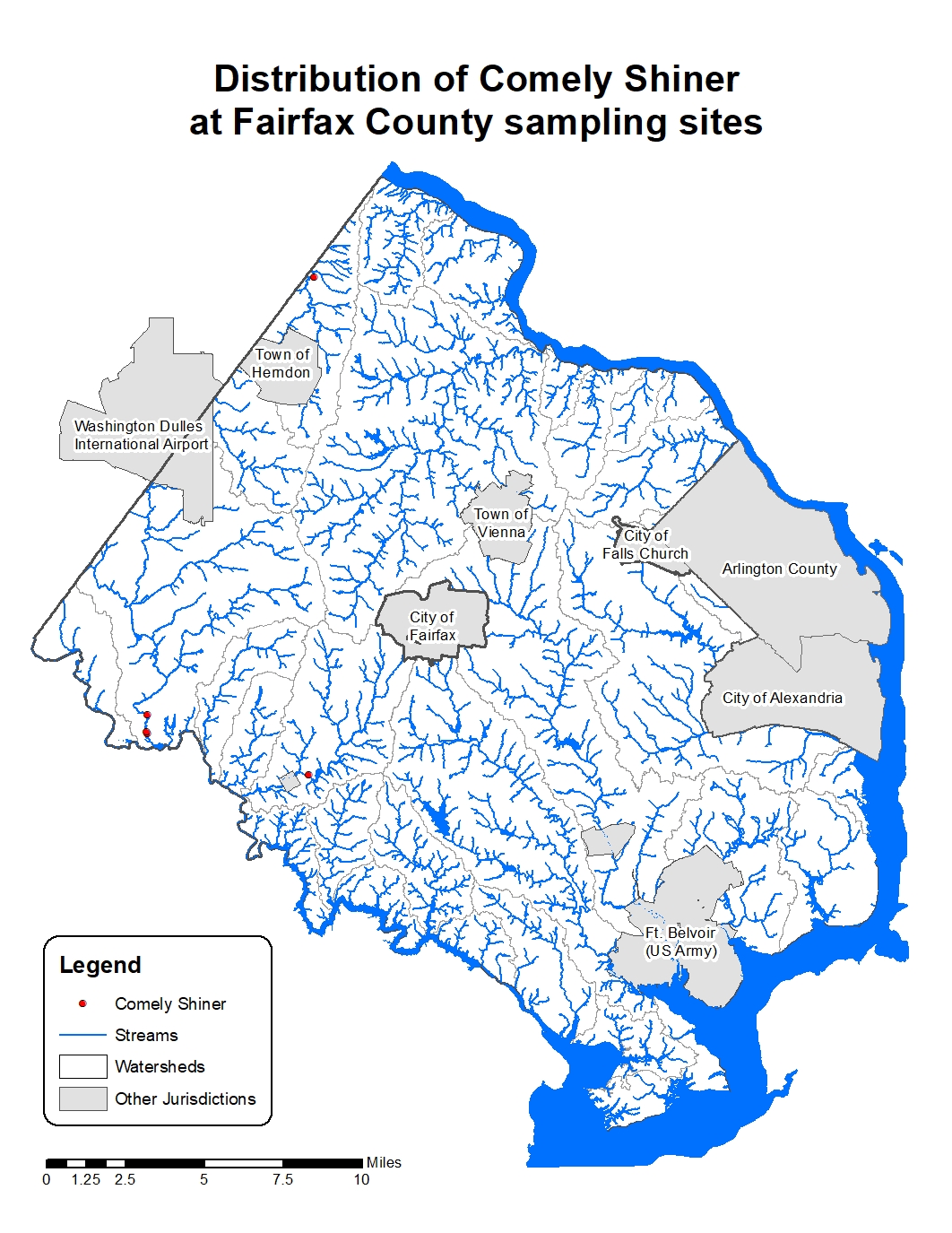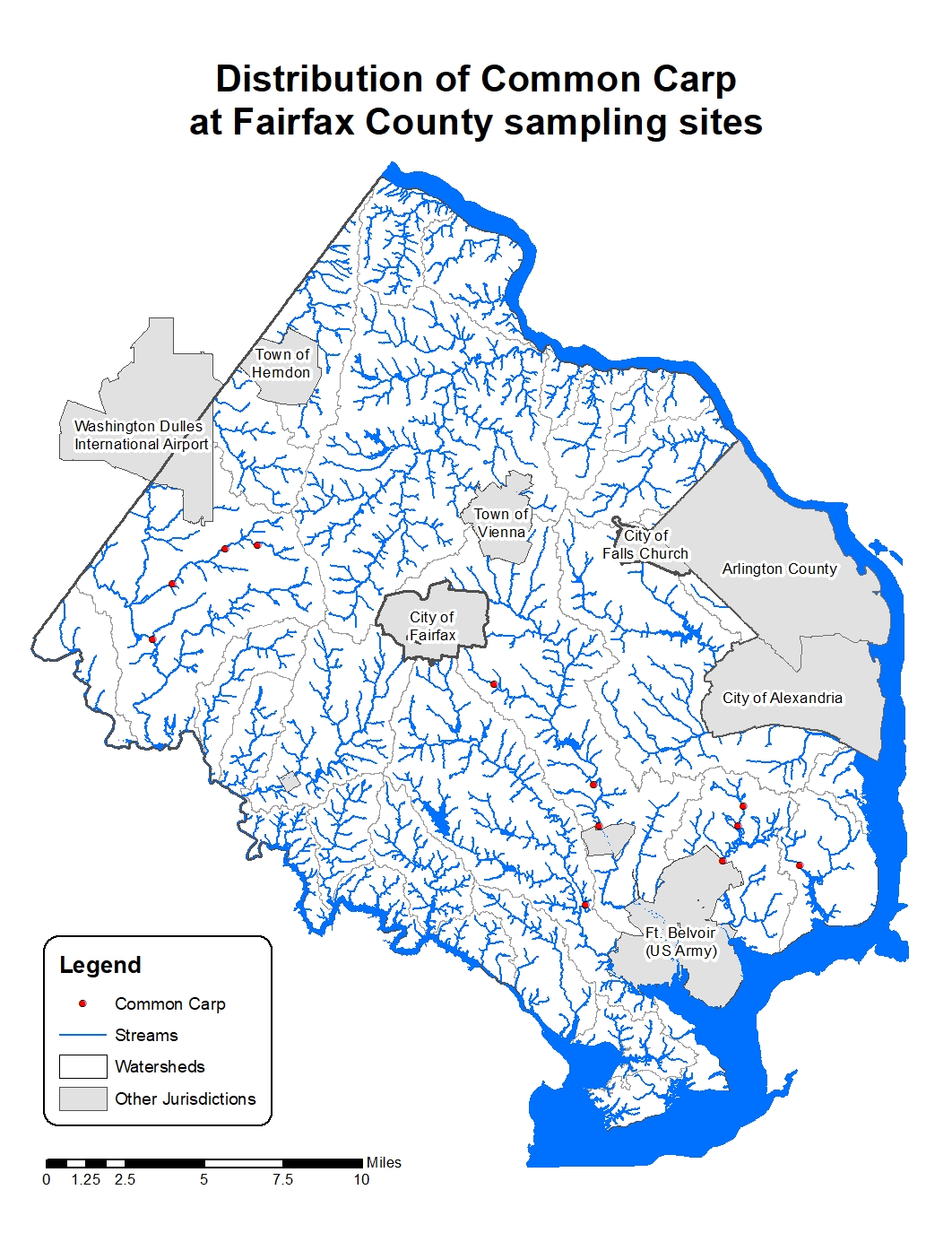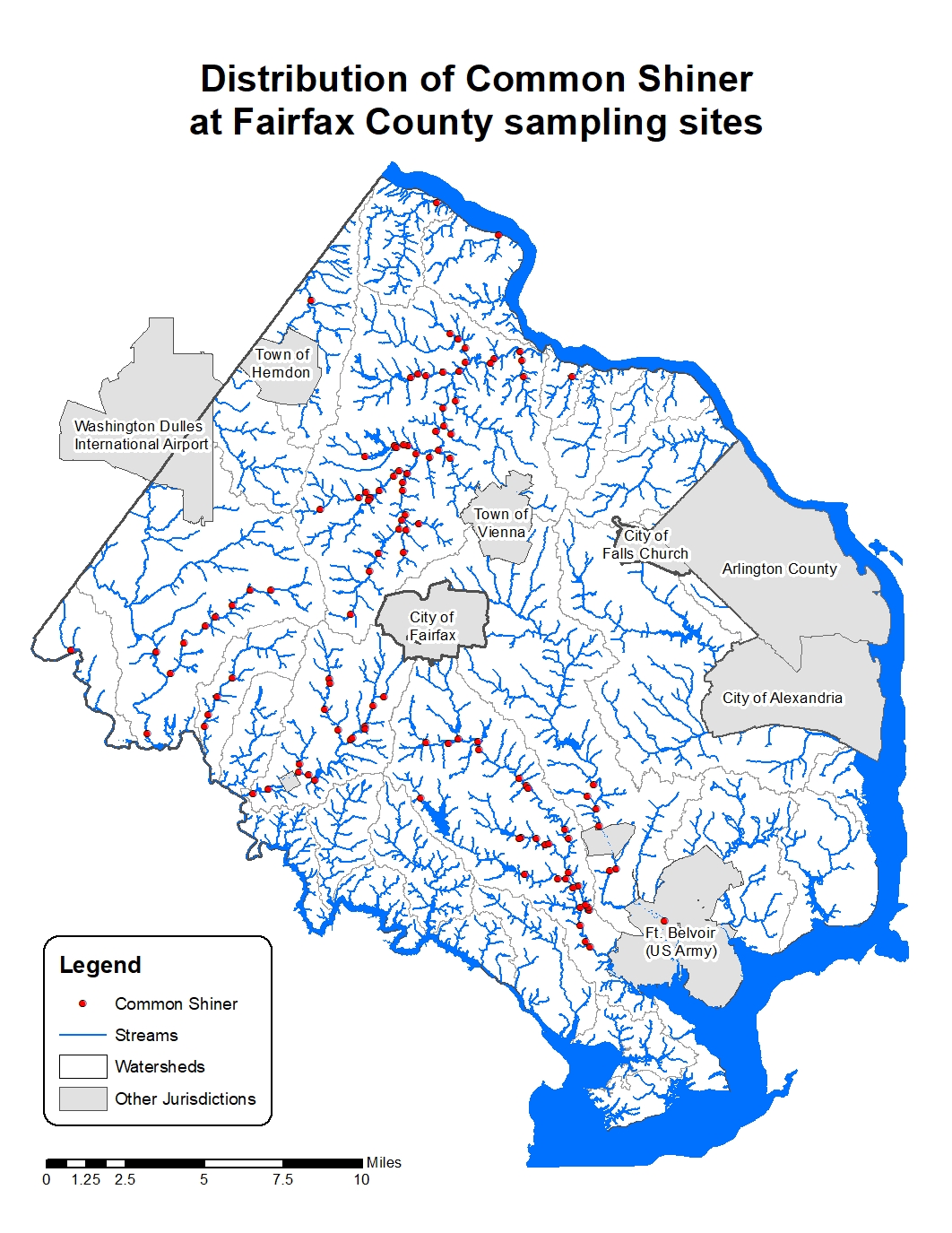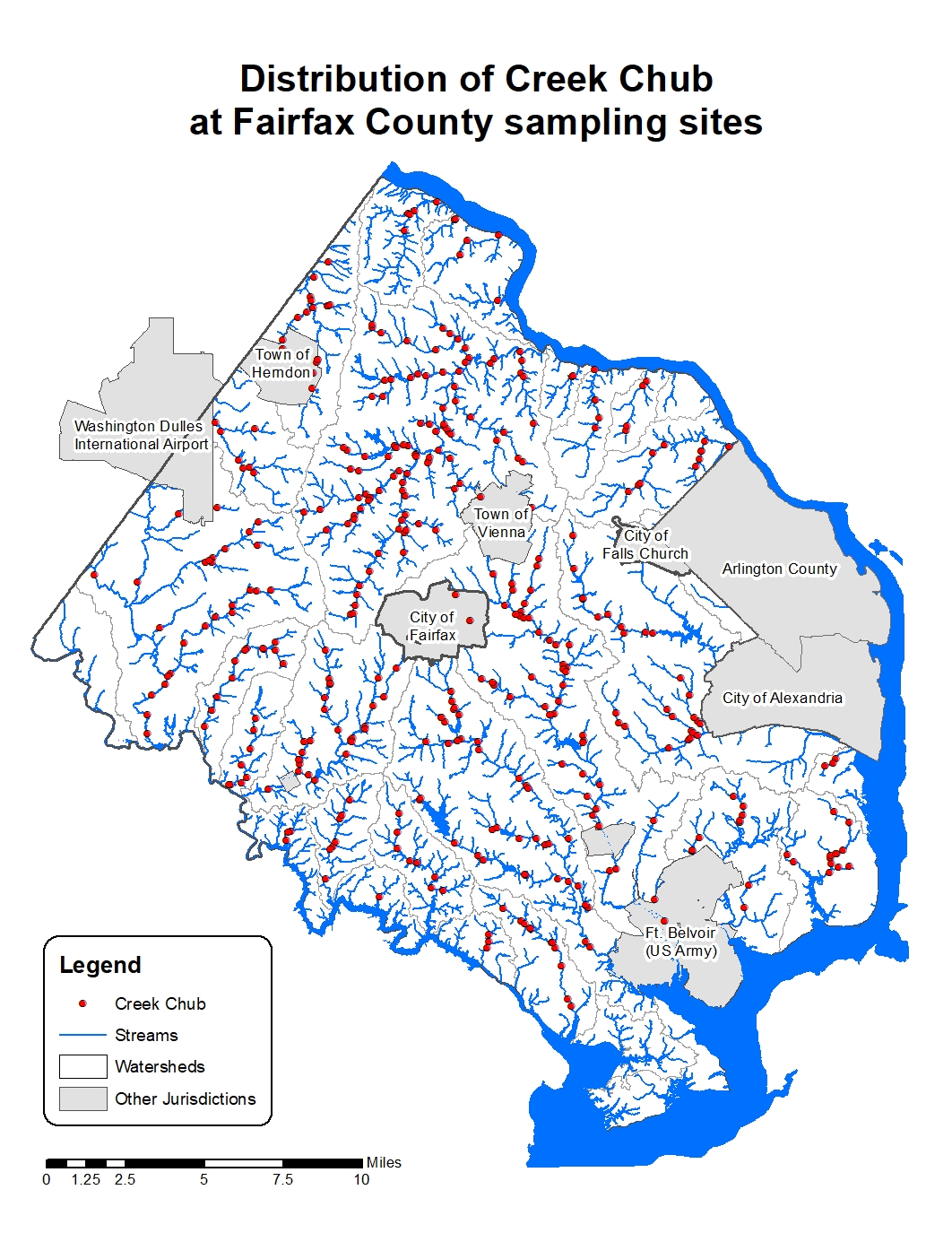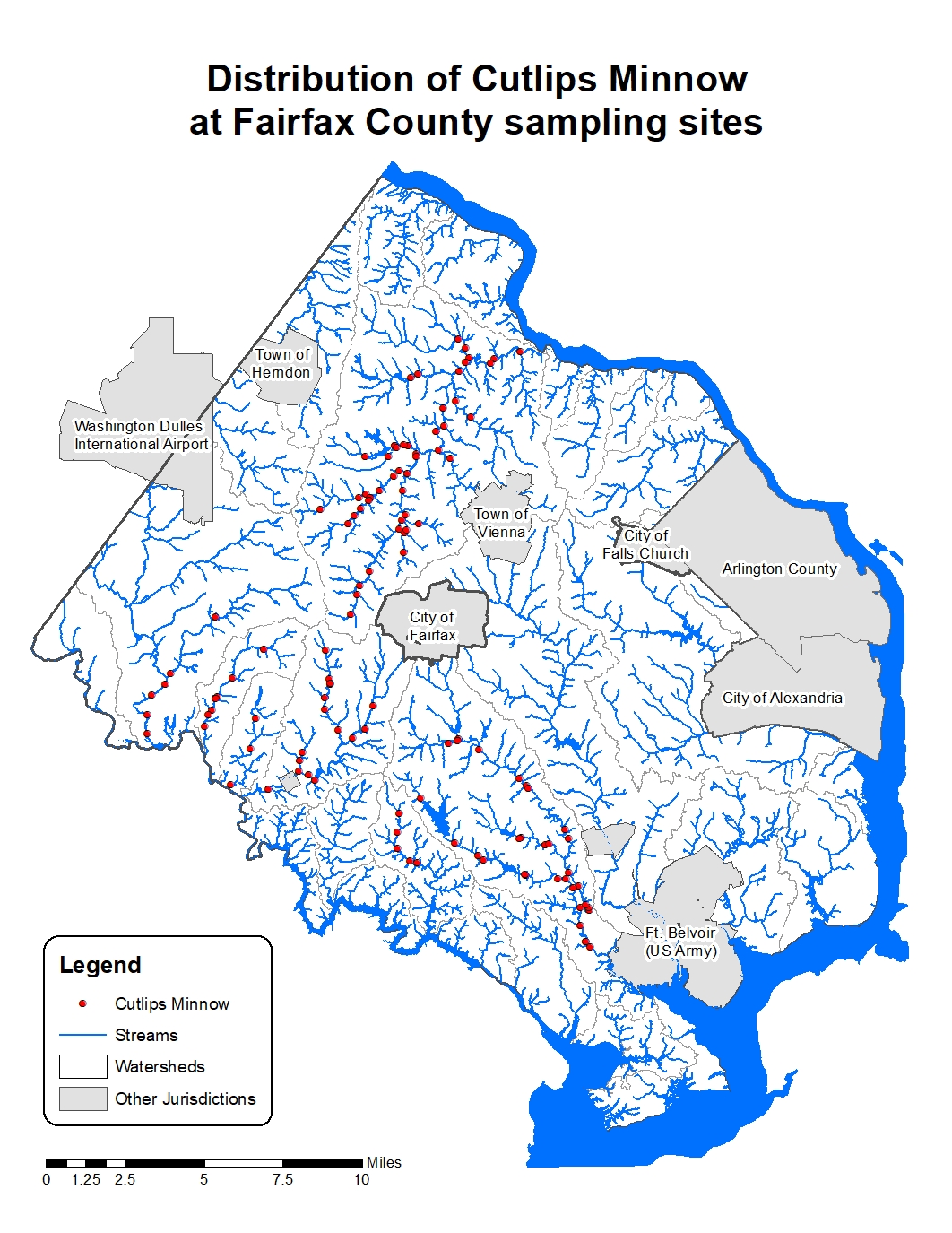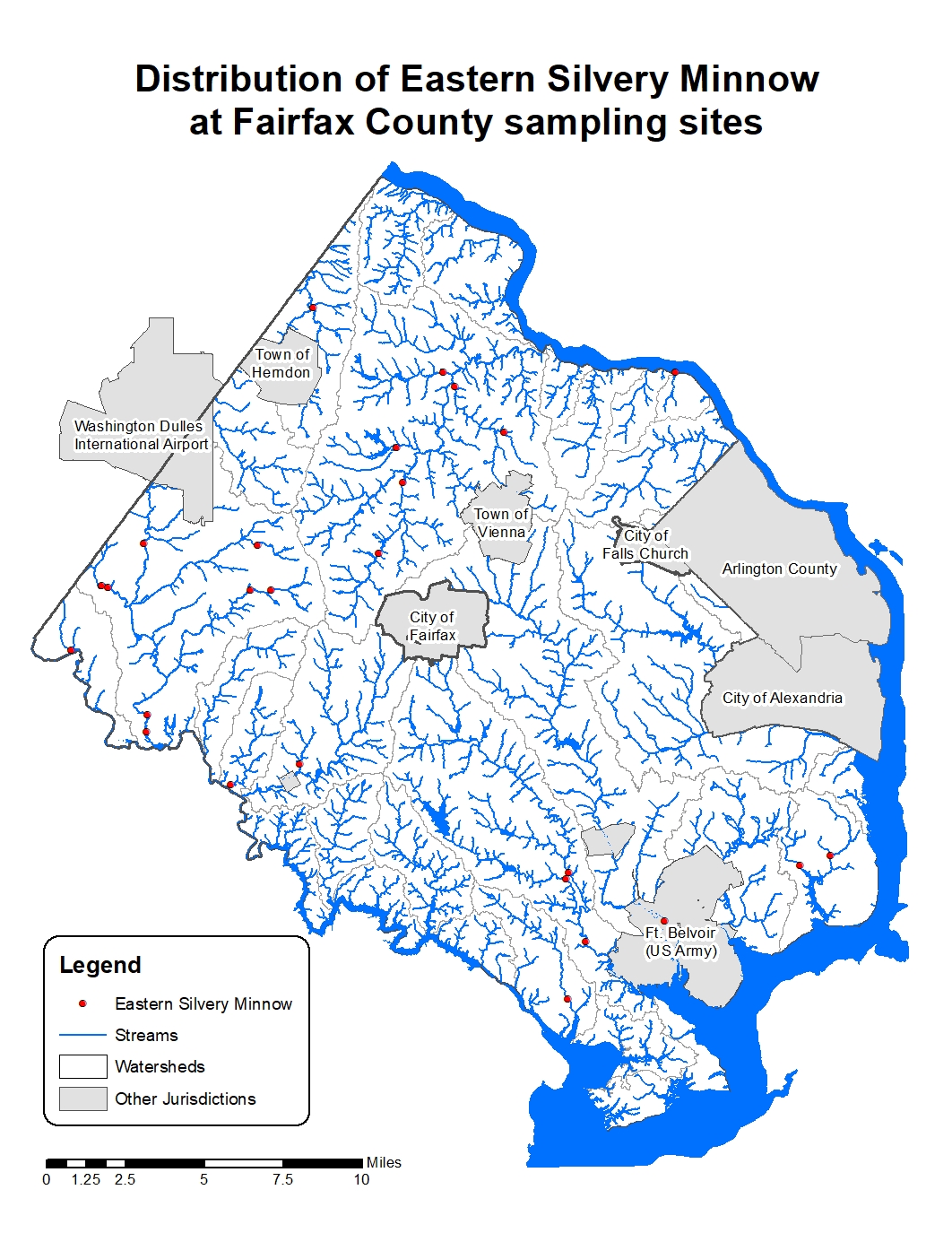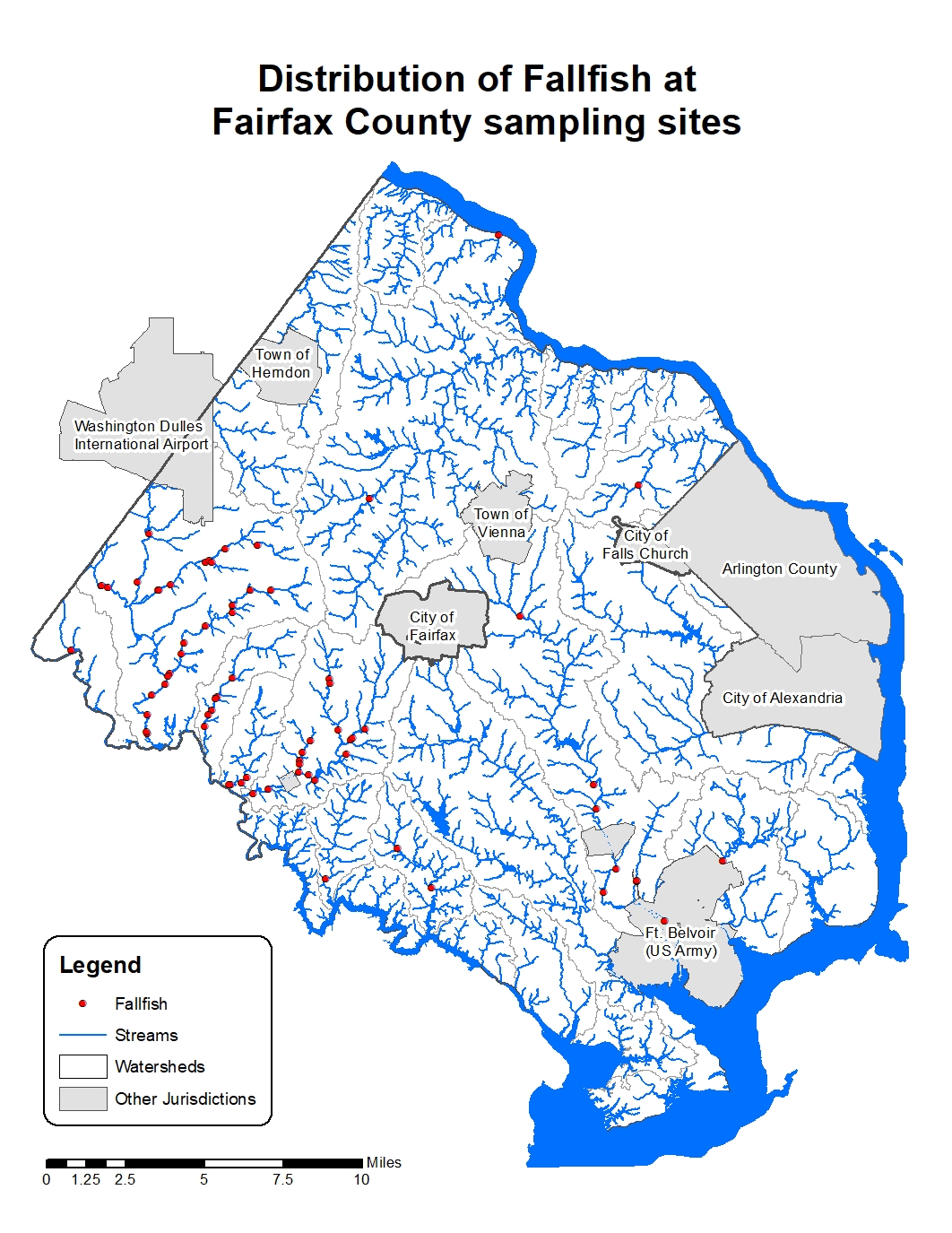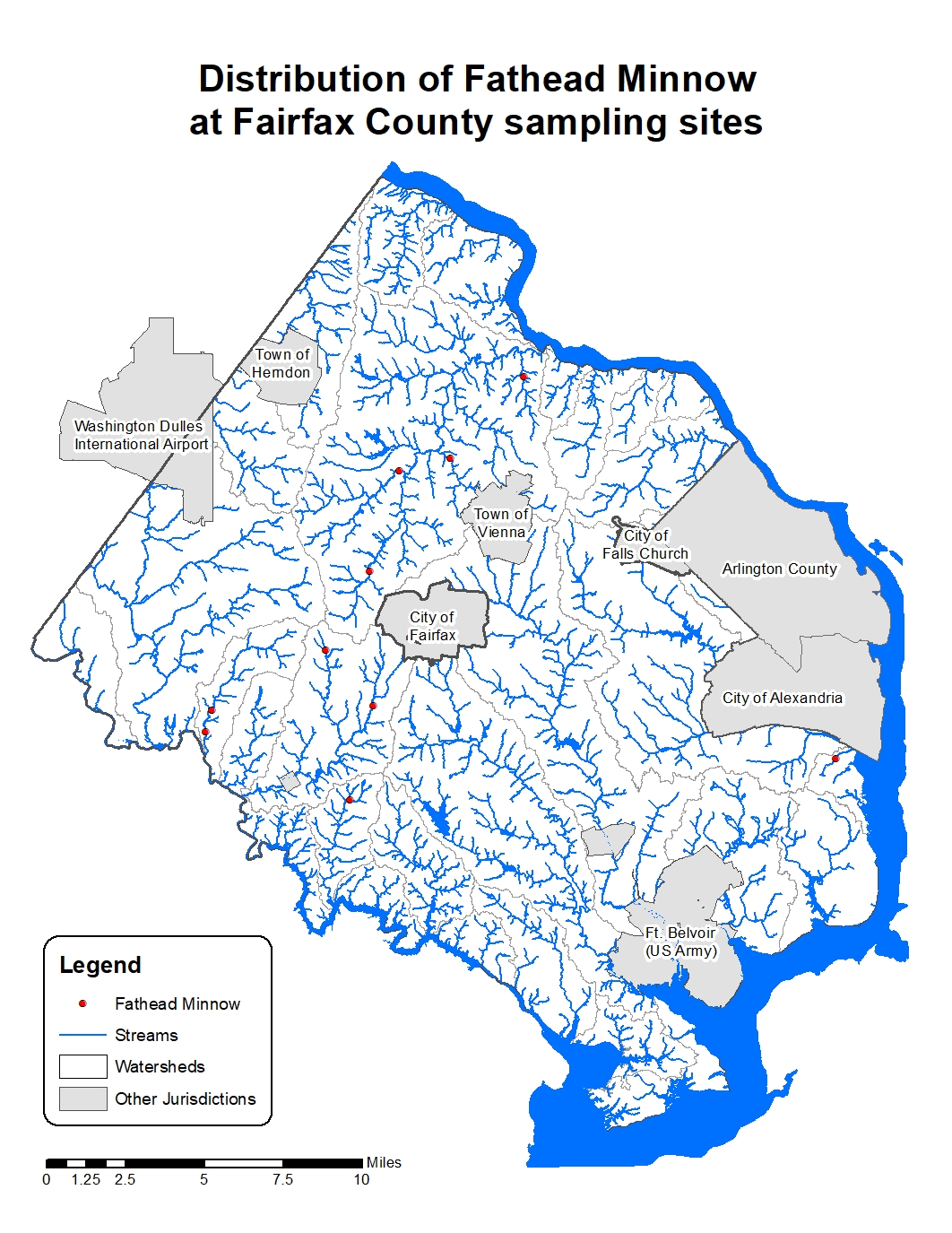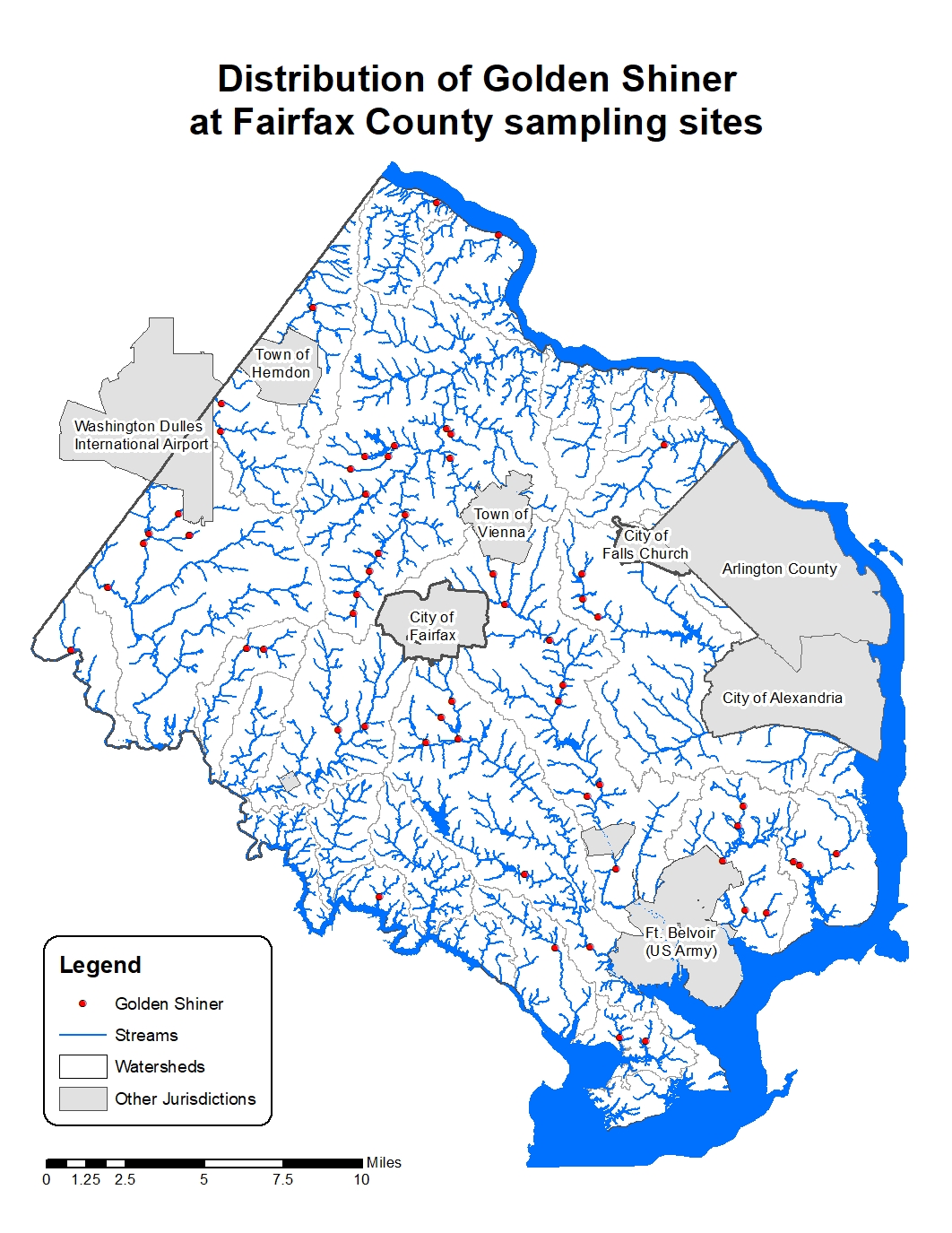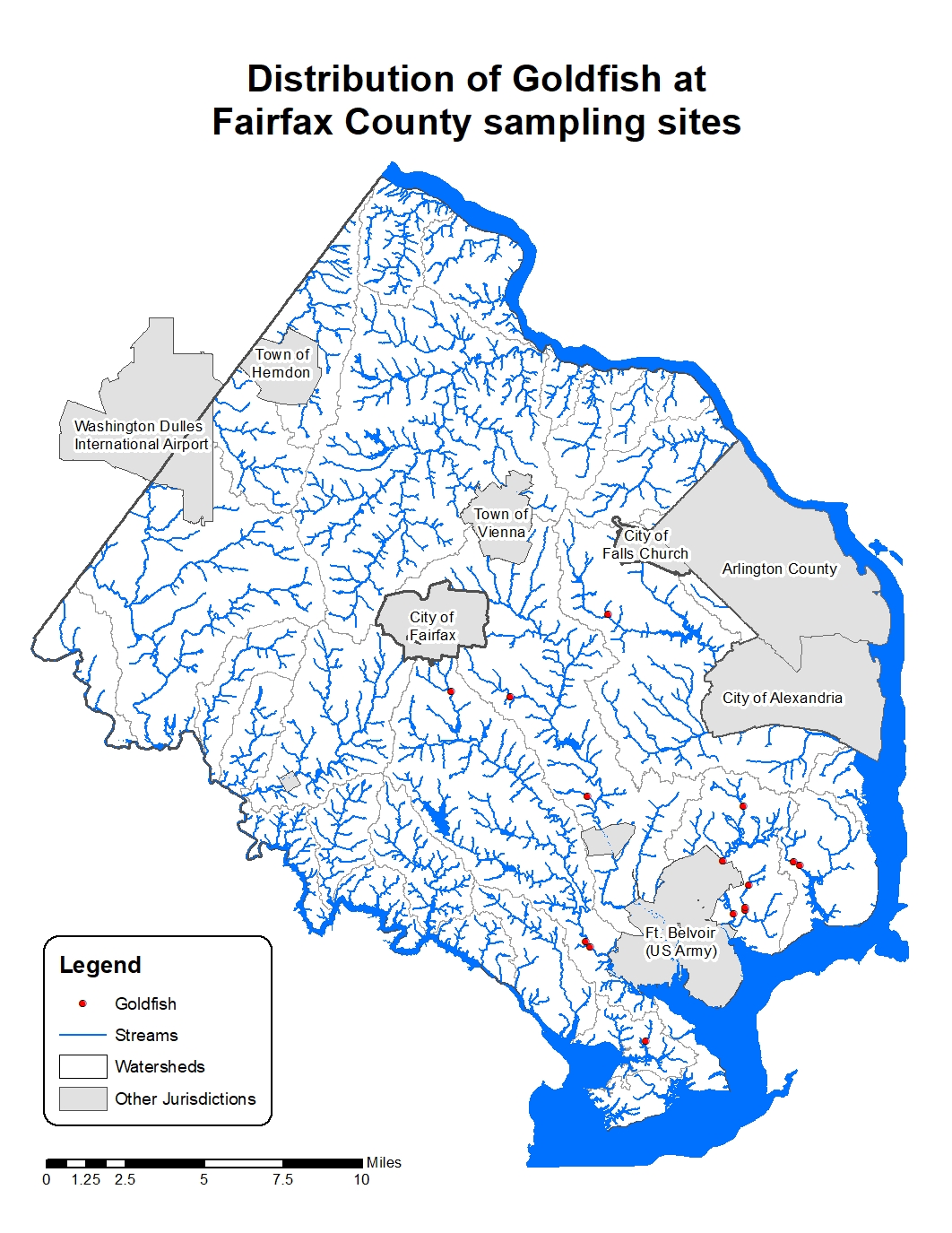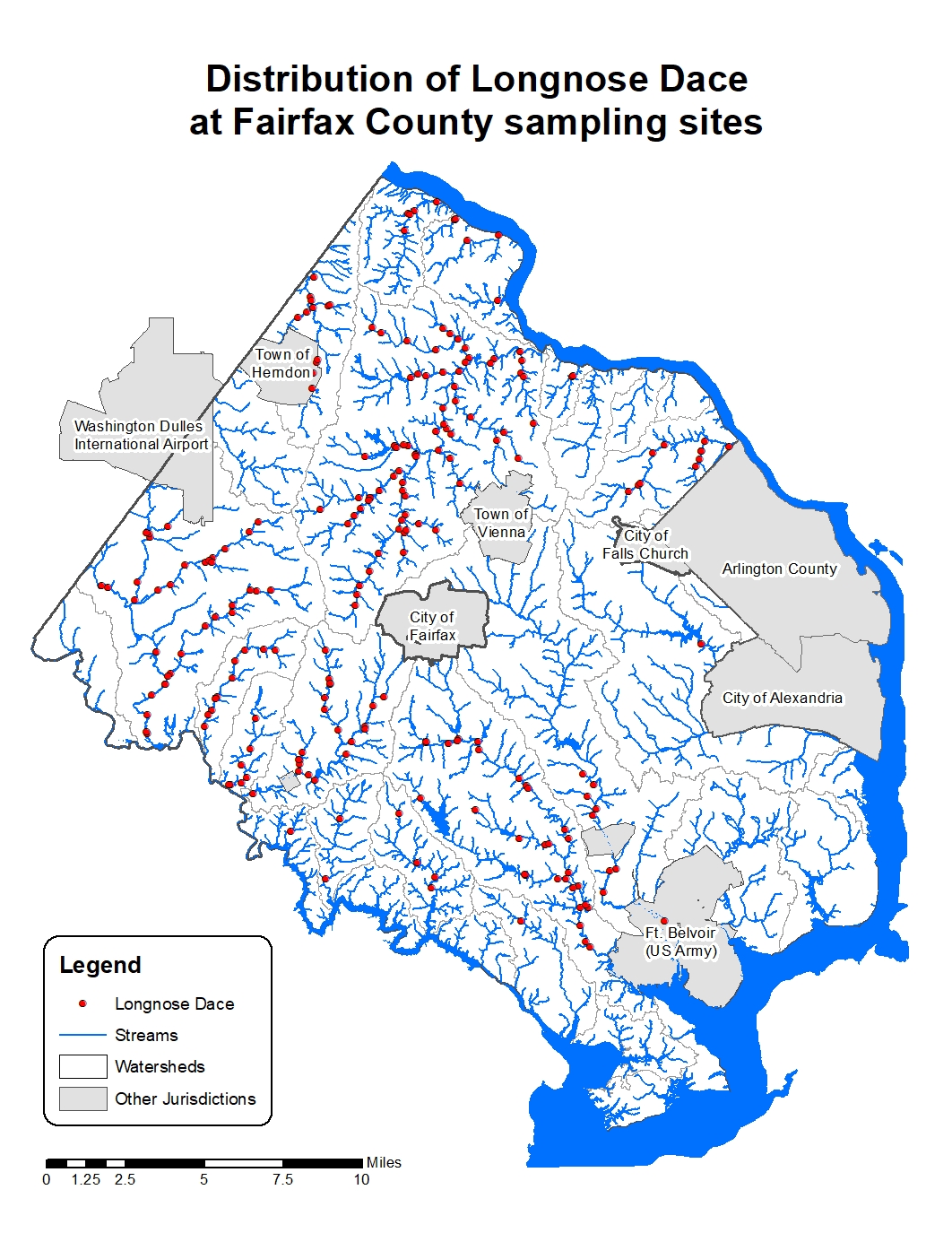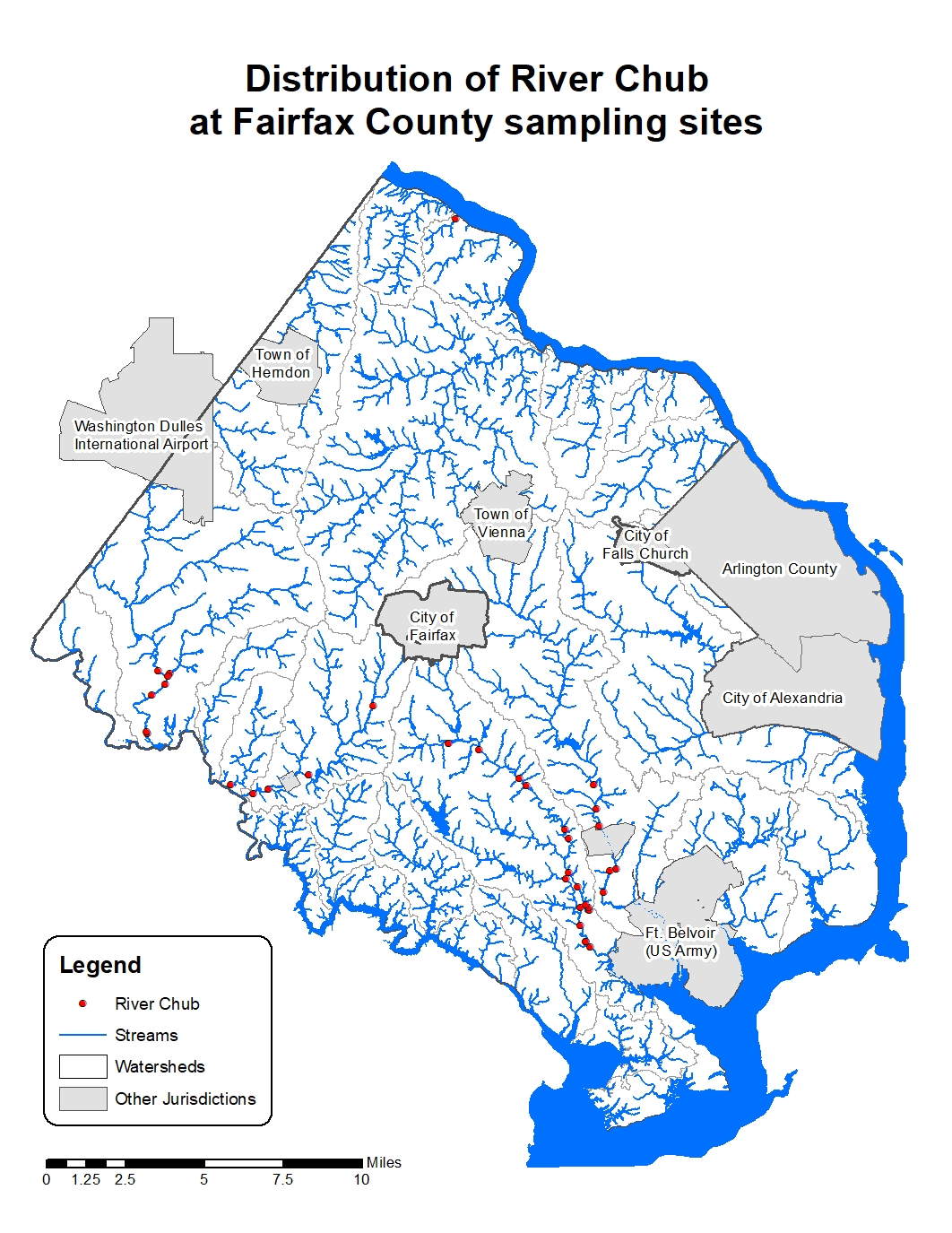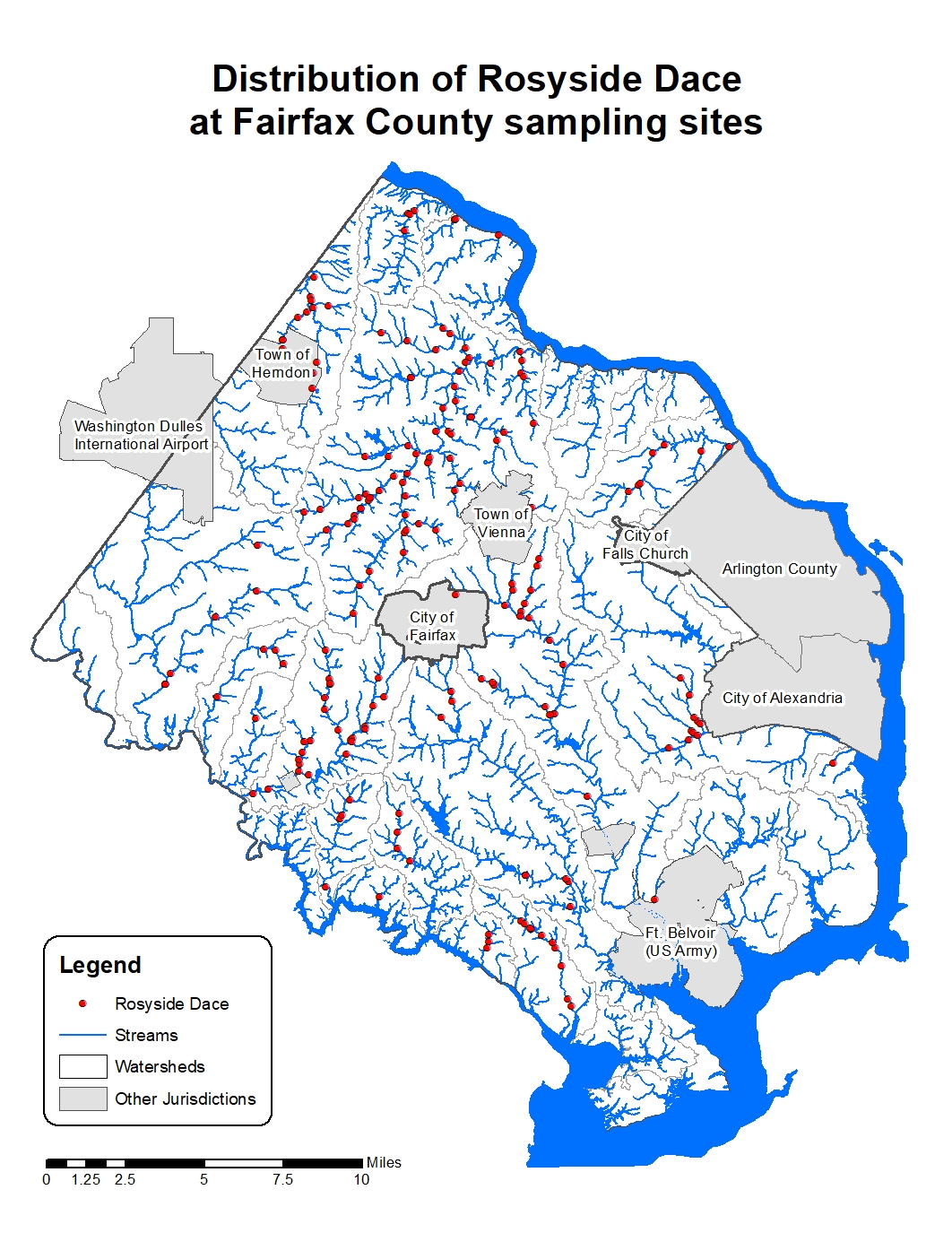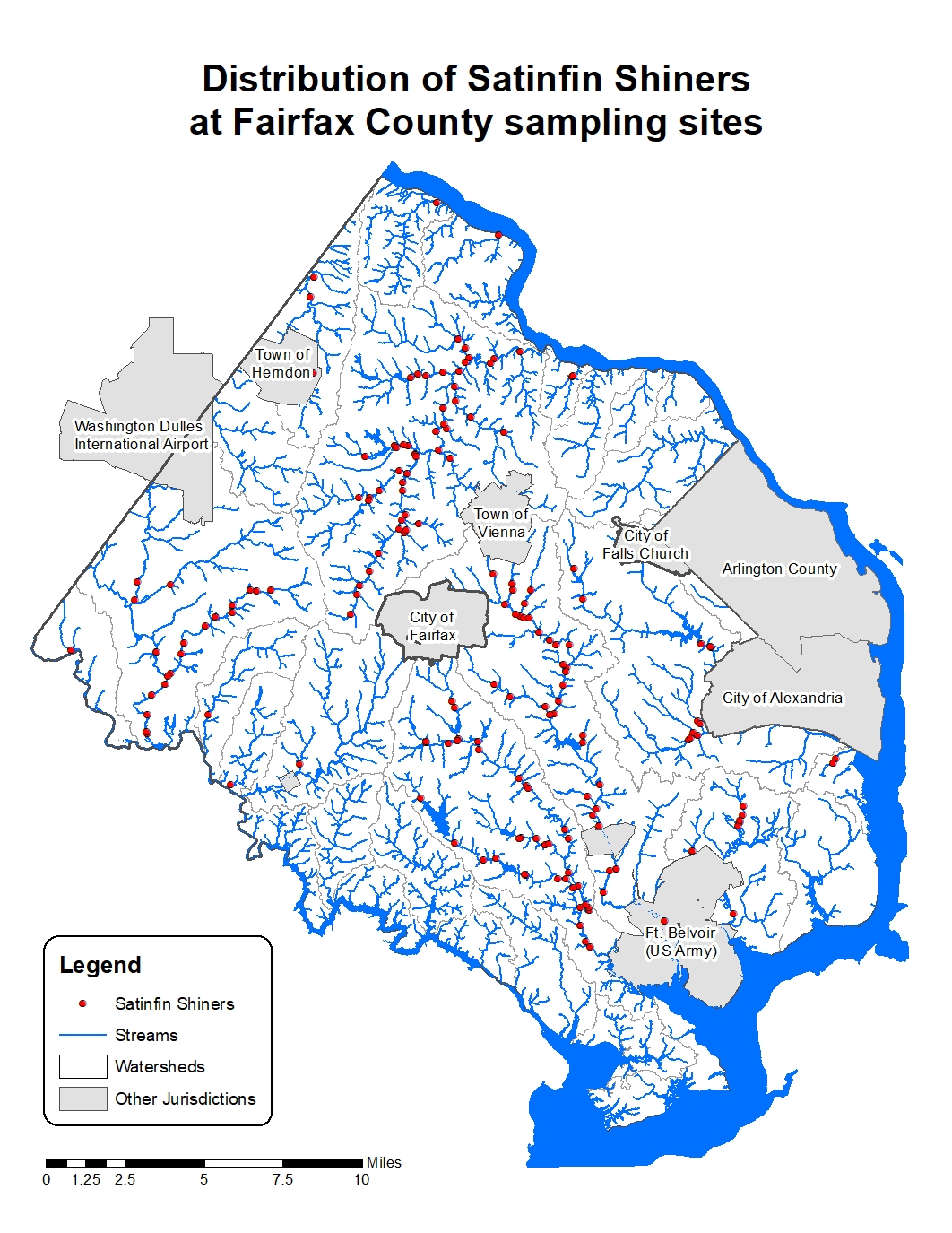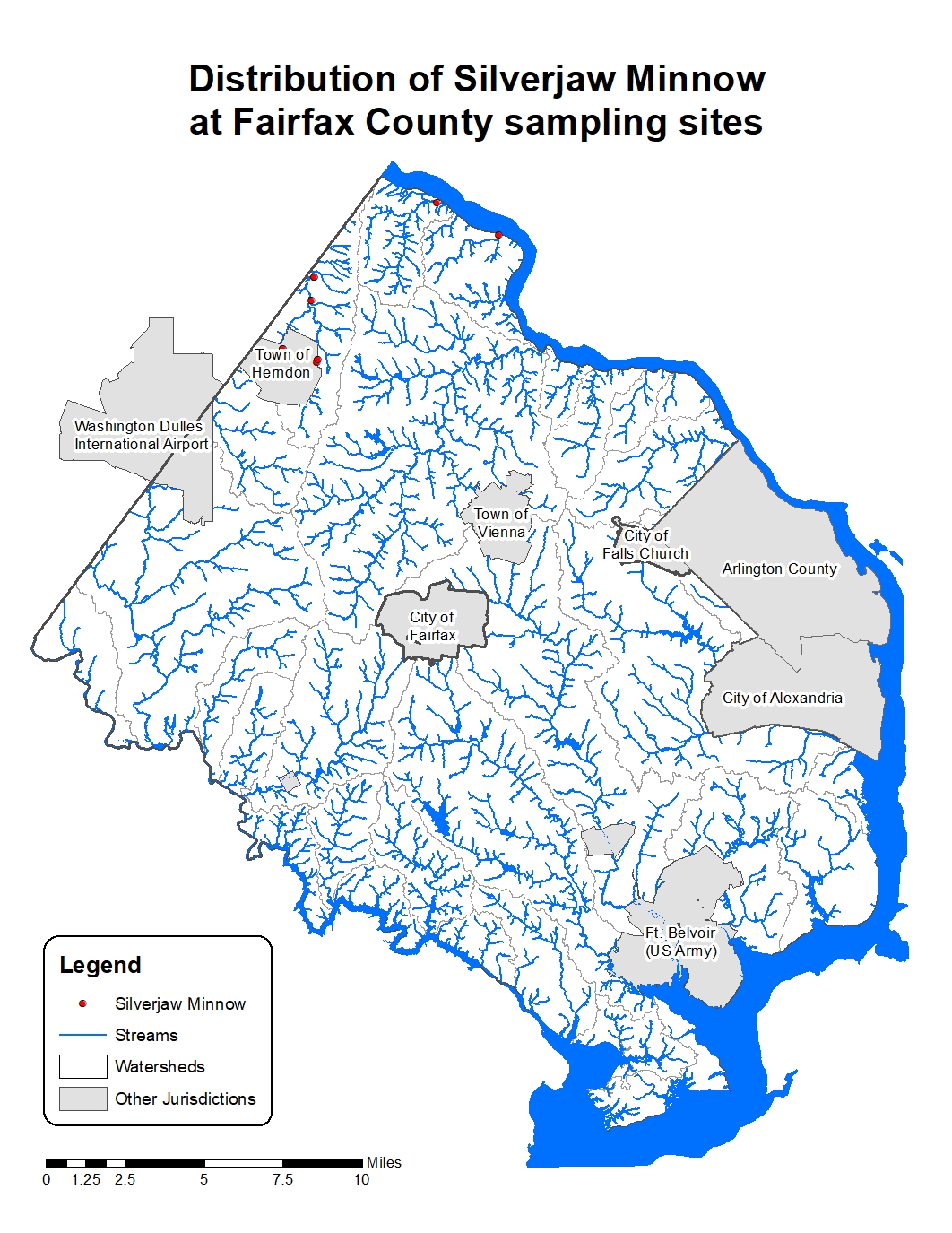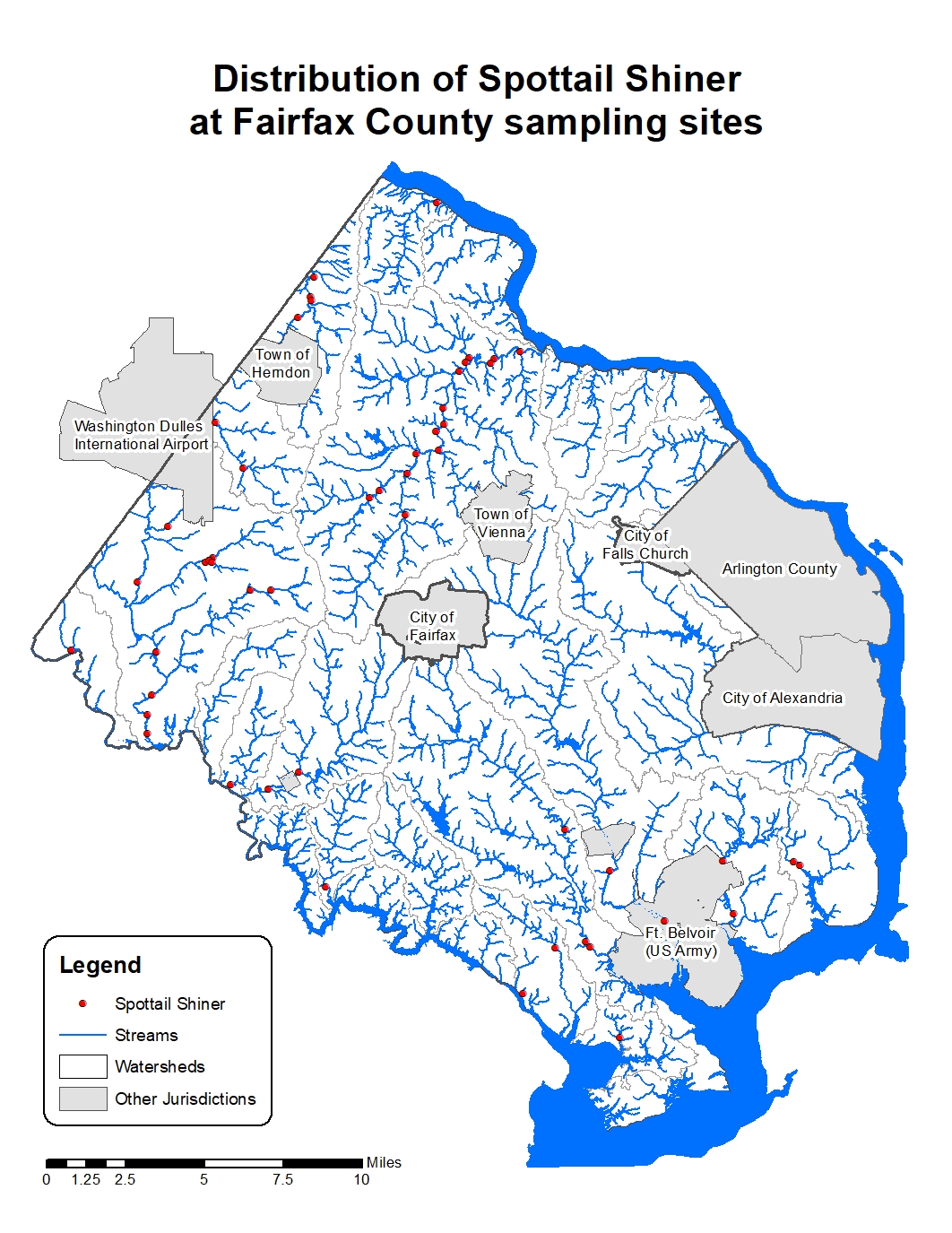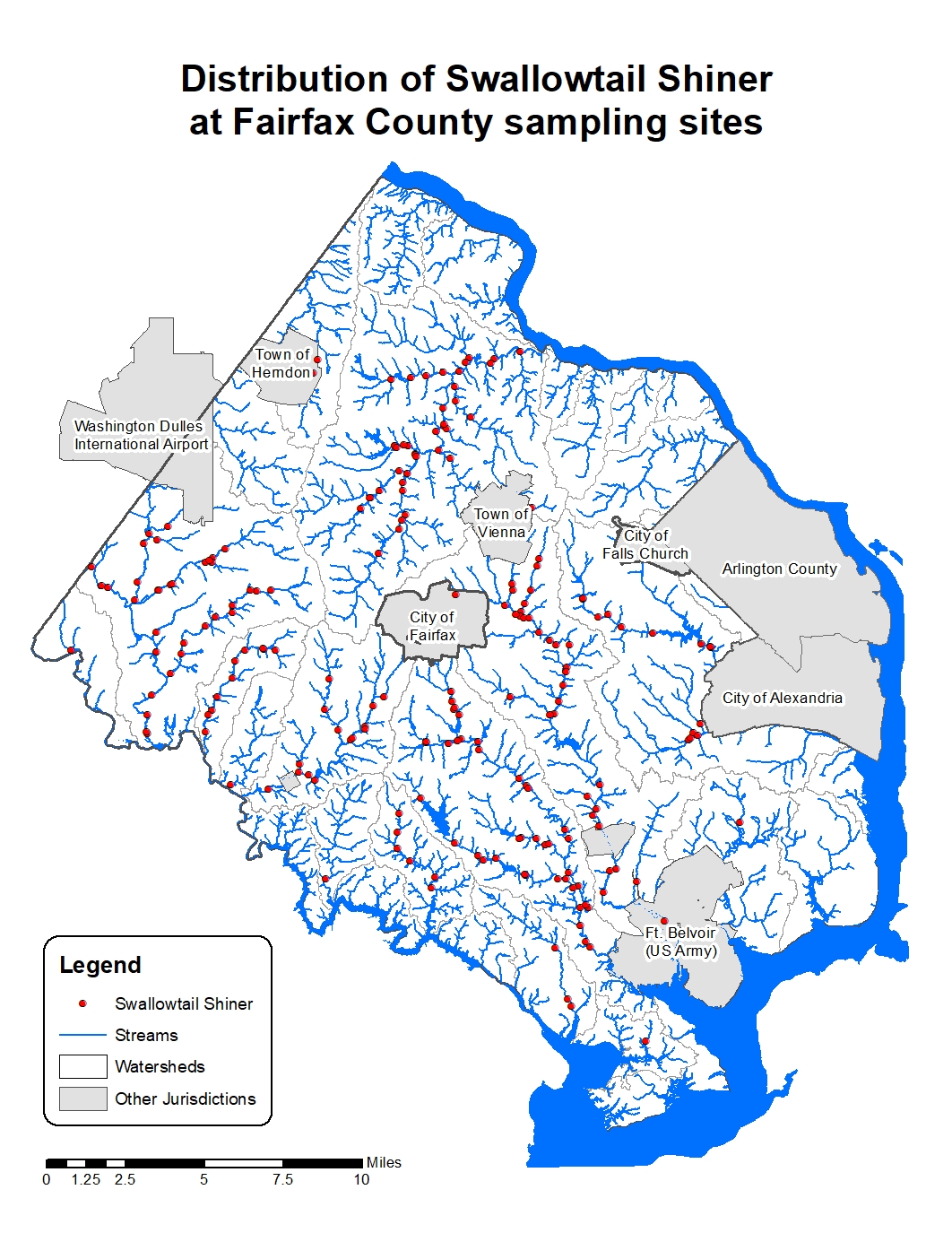On This Page
Blacknose Dace
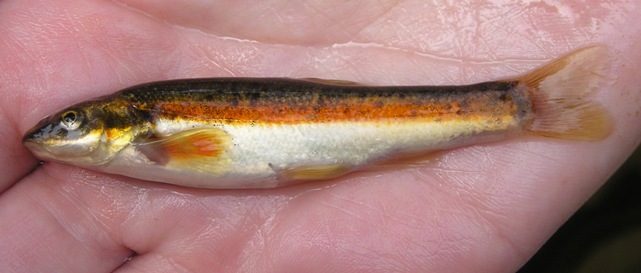
Scientific Name: Rhinichthys atratulus
Fairfax County Native: Yes
Size: Typically 2 to 3 inches
Diet: Aquatic and terrestrial insects, algae and detritus
Distribution sampling sites: Map
The blacknose dace is tolerant of a wide range of environmental conditions. The dace is so adaptable it is the most common fish collected in Fairfax County.
Bluntnose Minnow
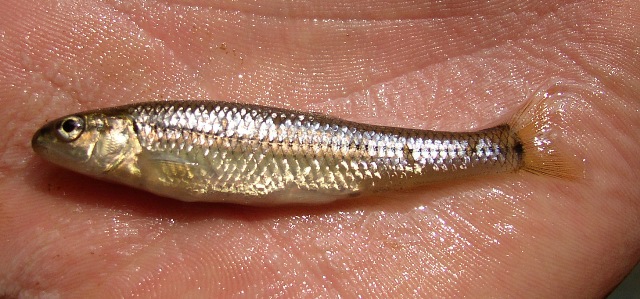
Scientific Name: Pimephales notatus
Fairfax County Native: Unknown, has spread quickly because of use as a bait species
Size: 3 inches, rarely to 4 inches
Diet: Aquatic insects and other small invertebrates
Distribution sampling sites: Map
Bluntnose minnows are named for their short, blunt noses. During breeding season, the bluntnose minnow sports numerous hard bumps on its snout called tubercles.
Central Stoneroller
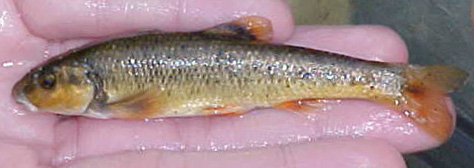
Scientific Name: Campostoma anomalum
Fairfax County Native: Yes
Size: 5 inches, rarely to 7 inches
Diet: Algae and detritus
Distribution sampling sites: Map
The central stoneroller is perfectly adapted to eat algae. It has a hard jaw ridge adapted to scrape algae off rocks. To help digest the algae, this fish has the longest intestine compared to its size of any American minnow.
Comely Shiner
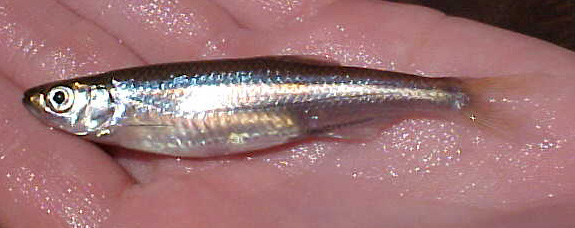
Scientific Name: Notropis amoenus
Fairfax County Native: Yes
Size: 3 inches, rarely larger
Diet: Unknown
Distribution sampling sites: Map
The comely shiner is rare in Fairfax County. Due to its small size and rarity, not much is known about this minnow.
Common Carp
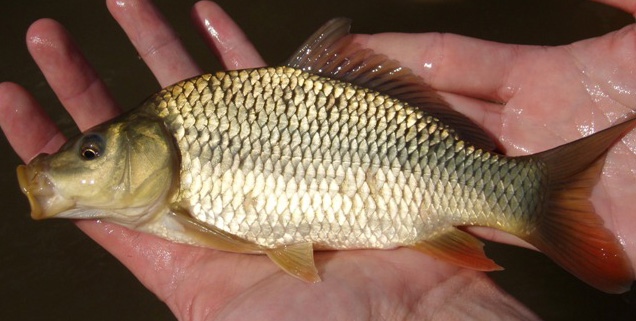
Scientific Name: Cyprinus carpio
Fairfax County Native: No
Size: 30 inches, rarely to 40 inches
Diet: Aquatic invertebrates, plants, seeds, berries
Distribution sampling sites: Map
The common carp is the largest member of the minnow family. The Virginia state fishing record is just over 49 pounds. Because of its large size, it typically inhabits large rivers and lakes. Specimens collected in Fairfax County are probably individuals pushed out of the lakes by heavy rains.
Common Shiner
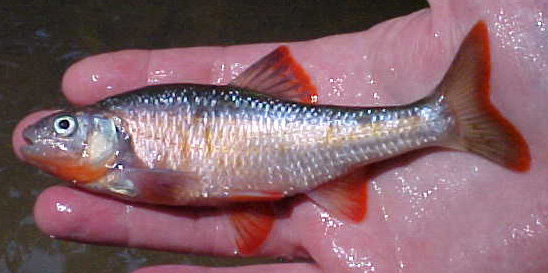
Scientific Name: Luxilus cornutus
Fairfax County Native: Yes
Size: 4 inches, rarely exceeding 5 inches
Diet: Aquatic and terrestrial insect, small invertebrates, algae and detritus
Distribution sampling sites: Map
During the spring breeding season, the common shiner males’ fins turn a bright red making this fish quite stunning.
Creek Chub
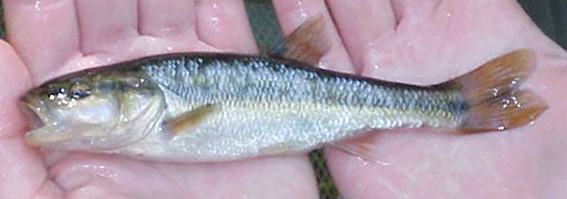
Scientific Name: Semotilus atromaculatus
Fairfax County Native: Yes
Size: 8 inches, rarely to 12 inches
Diet: Fish, crayfish and small frogs
Distribution sampling sites: Map
Next to the blacknose dace, the creek chub is the second most common fish in Fairfax County. The creek chub grows large enough for it to be caught by fisherman on artificial lures.
Cutlips Minnow
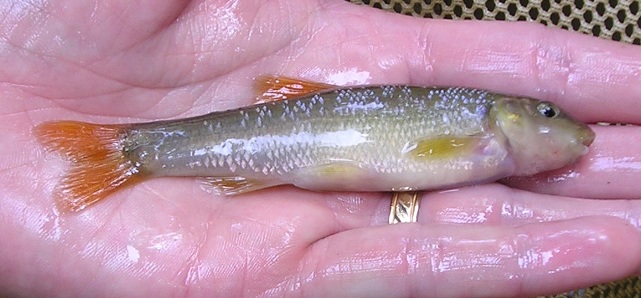
Scientific Name: Exoglossum maxillingua
Fairfax County Native: Yes
Size: 6 inches
Diet: Aquatic insects, snails and mollusks
Distribution sampling sites: Map
The cutlips minnow has a highly specialized lower jaw that is split into three lobes. While the exact reason for the split is debatable, it is theorized that it is used to help dislodge snails and insects from the stream bottom and to help crush mollusks for food.
Eastern Silvery Minnow
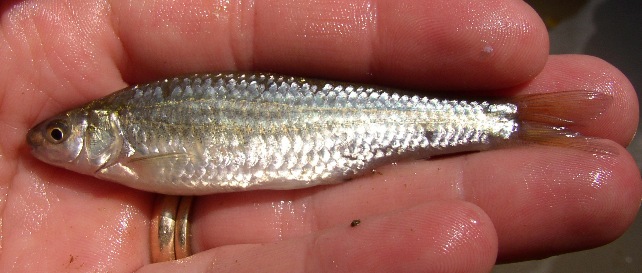
Scientific Name: Hybognathus regius
Fairfax County Native: Yes
Size: 3.5 inches, rarely to 5 inches
Diet: Algae and detritus
Distribution sampling sites: Map
The eastern silvery minnow has a very long intestine adapted to digest algae and detritus. Its plain looks make it a difficult minnow to identify.
Fallfish

Scientific Name: Semotilus corporalis
Fairfax County Native: Yes
Size: 12 inches
Diet: Aquatic and terrestrial insects, crayfish, fish and algae
Distribution sampling sites: Map
Fallfish are large minnows that build the largest stone nests among fishes during breeding season. These mounds can be up to three feet in height.
Fathead Minnow
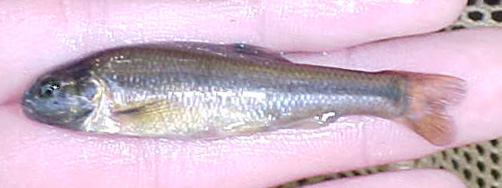
Scientific Name: Pimephales promelas
Fairfax County Native: No, probably introduced as a bait
Size: 2.5 inches, rarely above 3 inches
Diet: Insects, algae and detritus
Distribution sampling sites: Map
The fathead minnow is a popular bait fish which has led to its large distribution across the eastern United States. This fish is hardy and is used by scientists to test the effects of chemicals.
Golden Shiner
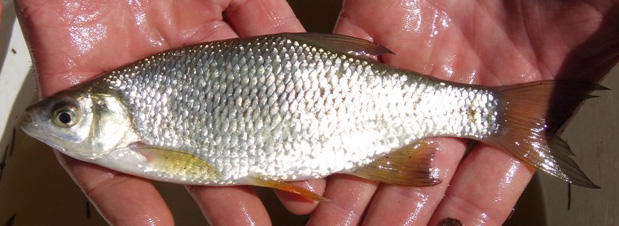
Scientific Name: Notemigonus crysoleucas
Fairfax County Native: Probably, but widespread use as a bait minnow has expanded its range considerably
Size: 7 inches, rarely to 10 inches
Diet: Terrestrial and aquatic insects, plant matter
Distribution sampling sites: Map
The golden shiner is a staple in the bait world, which has resulted in its large distribution. The name is a reference to the golden color that appears in some of the species.
Goldfish
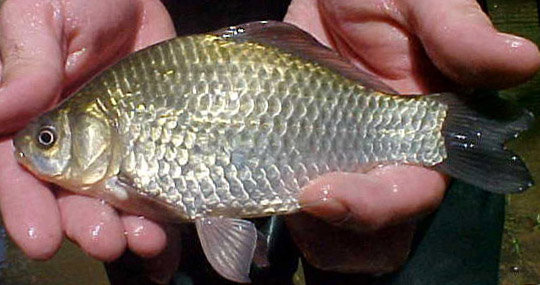
Scientific Name: Carassius auratus
Fairfax County Native: No
Size: 16 inches
Diet: Aquatic insects, plant matter and small fish
Distribution sampling sites: Map
Goldfish were first introduced to the United States in the late 1600s. Goldfish are naturally a silvery bronze color and not the bright orange you see in the pet stores.
Longnose Dace
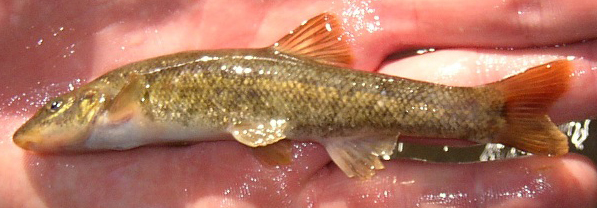
Scientific Name: Rhinichthys cataractae
Fairfax County Native: Yes
Size: 3 to 4 inches, rarely to 5 inches
Diet: Aquatic insects and other small invertebrates
Distribution sampling sites: Map
This native minnow is well adapted to living in swift running water. It has a down sloped nose and a rudimentary gas bladder which allows them to live easily in the swift current.
River Chub
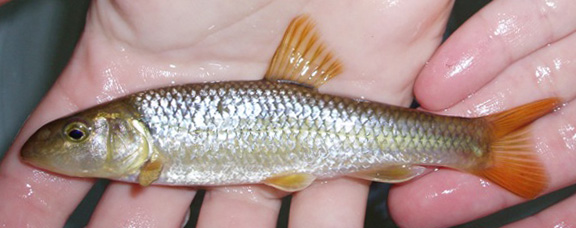
Scientific Name: Nocomis micropogon
Fairfax County Native: Yes
Size: 7 inches, rarely to 9 inches
Diet: Aquatic insects and other small invertebrates
Distribution sampling sites: Map
As its name implies, the river chub is found mainly in medium to large rivers. In Fairfax County they were found on the main stems of Accotink Creek, Pohick Creek, Cub Run and Popes Head Creek. During the breeding season the males develop tubercles to defend their nest.
Rosyside Dace
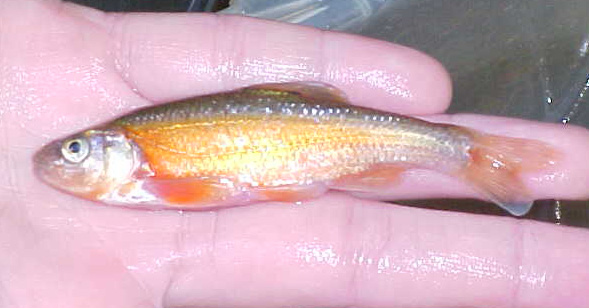
Scientific Name: Clinostomus funduloides
Fairfax County Native: Yes
Size: 3 to 4 inches
Diet: Aquatic and terrestrial insects and other small invertebrates
Distribution sampling sites: Map
The rosyside dace is a nest associate which means they breed over other fish species' nests. This has led to some cases of hybridization with river chubs, creek chubs and fallfish.
Satinfin Shiners
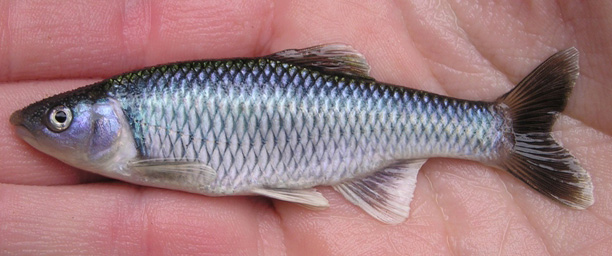
Scientific Name: Cyprinella spp.
Fairfax County Native: Yes
Size: 3 inches, rarely to 4 inches
Diet: Aquatic and terrestrial insects and other small invertebrates
Distribution sampling sites: Map
Two species of satinfin shiner are found in Fairfax County; the spotfin shiner and the satinfin shiner. The satinfin shiners have a reputation as a good aquarium fish because of their active nature and their acceptance of dried fish food.
Silverjaw Minnow
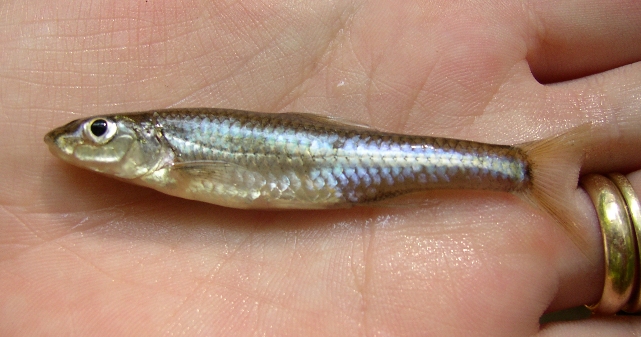
Scientific Name: Notropis buccatus
Fairfax County Native: Unknown
Size: 2.5 inches, rarely to 3 inches
Diet: Benthic macroinvertebrates
Distribution sampling sites: Map
The silverjaw has a canal structure below its eye that allows vibrations created by prey to be detected.
Spottail Shiner
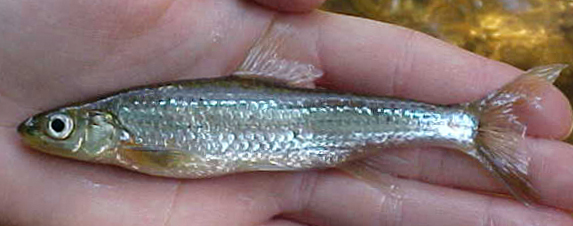
Scientific Name: Notropis hudsonius
Fairfax County Native: Yes
Size: 3.5 inches, rarely to 5 inches
Diet: Aquatic and terrestrial insects and other small invertebrates
Distribution sampling sites: Map
The spottail shiner is a large shiner that is typically found in medium to large streams and rivers and can survive in tidal brackish waters.
Swallowtail Shiner
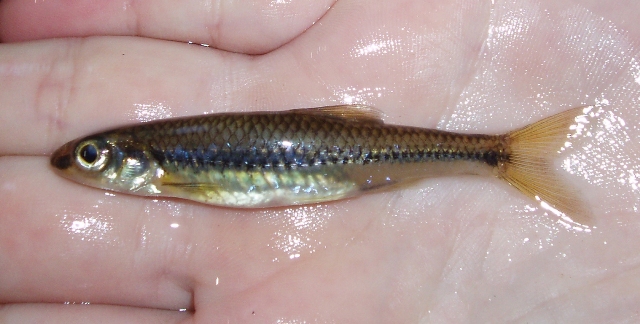
Scientific Name: Notropis procne
Fairfax County Native: Yes
Size: 2.5 inches
Diet: Most small aquatic invertebrates
Distribution sampling sites: Map
Like the cyprinella, the swallowtail shiner does well in aquaria and will readily breed if given the right conditions.





